A new study uses naloxone to explore why men get more relief from opioids – exo- and endogenous – than women.
The topic of women and pain is a hot one, now being given serious attention in the form of inquiries such as this.
But sex differences in pain, beyond women’s common experience of being taken less seriously and being offered less pain relief than men, seem to go beyond sexism.
Women have higher prevalence of chronic pain and a weaker analgesic response to administered opioids, say the authors of a pain study published in PNAS Nexus, and the latter effect seems to extend to endogenous opioids too.
In an attempt to fill in the blanks, the researchers from UC San Diego pooled data from a pair of double-blind randomised clinical trials aimed at exploring the role of the body’s natural opioids on regulating pain through meditation, and what happens when those natural opioids’ action is blocked.
Ninety-eight participants (51 women), a mix of people with chronic low back pain (n = 59) and pain-free individuals (n = 39) were allocated to complete four 20-minute sessions of real or sham mindfulness meditation.
Participants in the real mindfulness meditation group were taught to acknowledge their “thoughts, feelings and/or emotions without judgement or emotional reaction and to ‘simply return their attention back to the breath’ whenever such discursive events occurred”. The fake mindfulness sessions were designed “to lead participants to believe they were practising mindfulness-meditation without instructions relating to mindfully attending to the breath in a non-evaluative manner”.
After the four weeks of mindfulness meditation training, participants visited the lab at UCSD on two occasions. Baseline pain sensitivity ratings were taken by recording the response to heat stimuli delivered by a small hotplate placed on the calf muscle.
Participants then received a weight-based intravenous dose of naloxone – a powerful opioid antagonist – or saline and were then instructed to start meditating as they had been taught to do in the earlier training sessions. Pain sensitivity ratings were repeated.
An interesting difference emerged between men and women: while meditation significantly reduced the reported levels of pain when saline was administered in both sexes, only women saw a similar reduction of pain ratings after receiving naloxone.
The researchers concluded that men and women rely on different endogenous mechanisms to regulate pain, suggesting this finding may explain why women typically don’t respond as well to opioids as men do.
Sex differences in endogenous analgesic systems “may be associated with a distinct evolutionary-based analgesic mechanisms supporting pain relief”, they say, noting that the endocannabinoid system is engaged more in women during analgesia than in men, that women have higher endocannabinoid receptor density and that they respond more to administered cannabinoids.
But “unfortunately” the current study was not designed to measure those effects.
(They also observed that the subjects with chronic pain “produced greater meditation-induced analgesia (−18%) than pain-free individuals”, which could be an effect of age.)
“These results underscore the need for more sex-specific pain therapies, because many of the treatments we use don’t work nearly as well for women as they do for men,” they write.
“This study provides the first clear evidence that sex-based differences in pain processing are real and need to be taken more seriously when developing and prescribing treatment for pain.”
There’s that phrase again: taken seriously.
Further research is always needed, and in this case, about half the population will cheer you on.
Send burning story tips to penny@medicalrepublic.com.au.


